Create a free profile to get unlimited access to exclusive videos, sweepstakes, and more!
NASA's Mars rover shares new 2.4 billion-pixel, 360-degree panoramic image from Jezero

Since gently dropping down onto the Red Planet's surface on Feb. 18, NASA's amazing Perseverance Mars rover has been quite busy, trundling around Jezero Crater, deploying a little drone helicopter, making microphone recordings, and capturing more than 75,000 images of the surrounding terrain.
Now NASA has released the rover's latest photographic impressions of our neighboring planet in the form of an impressive 360-degree panorama pieced together using 992 separate images snapped by its Mastcam-Z stereo imaging system.
Perseverance Mars rover obtained these photos as it sat idle out at the “Van Zyl Overlook” inside the Jezero Crater while its accompanying Ingenuity Mars helicopter finished up its initial flights between April 15 and 26.
Hold your breath and have a look around...
Stitched together into a single mosaic, these images represent 2.4 billion pixels of Mars' barren world. The rover shot in this panorama was taken on Mar. 20, 2021 and added to deliver a more accurate sense of scale and perspective.
Imaging coverage of the sky has been digitally smoothed over based on the true observed sky color. The video's accompanying audio recording was created on Feb. 22, 2021 and contributes an eerie mood while you explore the landscape.
Per NASA, Perseverance is about to kick off its new science phase this month as it exits the “Octavia E. Butler” landing site.
““We are putting the rover’s commissioning phase as well as the landing site in our rearview mirror and hitting the road. Over the next several months, Perseverance will be exploring a 1.5-square-mile patch of crater floor,” said Jennifer Trosper, Perseverance project manager at NASA’s Jet Propulsion Laboratory, in a statement. “It is from this location that the first samples from another planet will be collected for return to Earth by a future mission.”


























